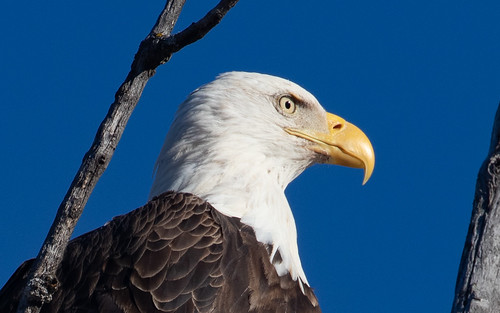Back in 2017, after a bizarre video about eagle “rebirth” went viral, people started flooding me with questions about whether it was true. According to the video, when an eagle is in its 40s, its long and flexible talons can no longer grab prey, its long sharp beak becomes bent, and its "old-aged, heavy wings become stuck to the bird’s chest making it impossible to fly." At this point, it has two options—die or go through a painful period of change that lasts 150 days. Despite those stuck wings, it magically flies to a mountaintop where it knocks its beak against a rock until it plucks it out. After a new beak grows in, it plucks out its talons and all its feathers. After this rebirthing ordeal, the renewed eagle takes off and lives for 30 more years, apparently hiding out from bird banders and the US Geological Survey Bird Banding Laboratory for the rest of its life so no one will ever confirm its longevity.
I wrote a blog post debunking every bit of the video, focusing on the Bald Eagle’s basic biology and natural history. The American Birding Association’s Rick Wright did a blog post about the historical underpinnings of the myth. And in the way that viral videos go, eventually people stopped emailing me about it.
Then this weekend, in 2020, I received an email from a man in St Vincent and the Grenadines in the Caribbean, who wrote:
In our morning devotions today, my wife read a scripture about the eagle renewing its strength. I wanted to find out more about that subject so I checked the internet and found your transcript commenting on the slides entitled as captioned, and I chuckled all the way through.
I also noted from your article the absence of information (documented or from personal experience) on the actual rebirth process. Is this a myth or is it factual?
Eagle "rebirth" is entirely mythical. A great many eagles have been banded as nestlings, and tracked through life, and this simply doesn't happen to them. Birds struggle through life as we humans do, and those lucky enough to grow old eventually die just as we humans do. People have always created myths about animals, such as that owls foretell a death, or a bird flying into a house is an omen. Augurs once told people's fortunes by killing birds and looking at their entrails.
We humans often long for a chance to start afresh. Myths about the Phoenix rising from the ashes and the eagle "rebirth" are meant to give us hope, and are often retold around the winter solstice, when nights are longest and darkest and we most long for light and rebirth—that's what New Year’s resolutions are all about. Every bird molts its feathers, a kind of rebirth. The beak and claws of captive birds often become overgrown and require trimming, but in nature, birds keep their bill and claw growth in check except in unique cases. Overgrown bills in chickadees in Alaska are caused by a novel picornavirus, and can happen to the birds at any age, but they don't have a magical rebirth to shed that overgrown bill.
It's comforting to imagine that eagles, and we, can be physically reborn, but I've found that watching and learning about real eagles in their natural habits is even lovelier and more comforting. Many of the naturalists of the 18th and 19th centuries studied animals specifically to better understand and appreciate God's creation. For them, learning about nature was a profoundly religious experience, drawing them closer to the creator. I wish people who were still promoting these animal myths would learn from their example.

